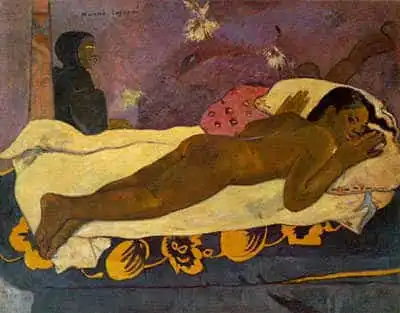FUNDAMENTALS |
BELIEFS A — Z |
|
INSPIRATION |
ENCYCLOPEDIA |
|
Spirits Spirit of the dead keeps watch. Oil painting by Paul Gauguin, 1892. Life Energy FundamentalsThe ancestral worship was yet another way of emphasizing the incorporeal existence as the superior and central one. The body died, but the mind seemed not to, so the former was a mere temporal vessel, and the latter was eternal — the true being. When ancestors became worshiped, thereby gradually transforming into deities in the minds of their descendants, this was simply a way of deifying the essence of the human being — his mind. Humans were locked into bodily existence for a short while, and then they would roam forever in their true immaterial shape. In most ancient beliefs, the minds of the deceased still remained on Earth, among the living, although mostly invisible to them. They could interfere in the daily lives of the living, so it was important to appease them by worship, offerings and such. Their existence was in no way perfect, but they seemed to be much better off than the living. Freed of their mortal coil, they had few worries or concerns, but their own honor. There is not much to be found in the ancient traditions about the exact nature of these deceased beings. They were usually believed to look the same as they had done in life — because that was how they were perceived in dreams and memories. In spite of those images, though, it was evident that they had left their bodies behind, so their incorporeal appearances were appearances only. They were images of the mind, for the mind, with no material equivalent. Today we would call them spirits, from the Latin Spiritus, which in turn is derived from the Greek pneuma, used in the original versions of the New Testament texts, referring to the Hebrew word ruach. All three words signify air, breath, or wind, connecting to the idea mentioned above of a life force contained in the air we breathe. But Homo rudis would not have regarded the life force as identical with the personality, the mind, so this use of the word 'spirit' is probably originally to signify invisibility and impalpability. The word ghost would be more accurate for the incorporeal and immortal minds of the deceased. Still, the link to the life force indicates that it was essential also to the dead, in their post-corporeal existence. This makes sense, since the life force could not be corporeal, or it would deteriorate with the body. If it was incorporeal, it would be present in whatever existence the mind entered when its body died. To Homo rudis, life manifested through body movements, but what was alive was the mind controlling them, and not the body being moved. So, the life force was something for the mind, and of its kind. Then it had to remain with the mind in the realm of the dead. The life force was sort of an eternal flesh of the mind. Spirits, or ghosts, were minds carried by the life force, but no longer attached to a material body.
Next
About CookiesMy Other Websites
Qi Energy ExercisesThe ancient Chinese life energy qi (chi) explained and how to exercise it.
Creation MythsCreation stories from around the world, and the ancient cosmology they reveal.
Cosmos of the AncientsWhat the Greek philosophers believed about the cosmos, their religion and their gods.
TaoisticTaoism, the ancient Chinese philosophy of life explained. Also, the complete Tao Te Ching online.
Other Books of Mine
The Greek philosophers and what they thought about cosmology, myth, and the gods. Click the image to see the book at Amazon (paid link). |
 Life Energy Encyclopedia
Life Energy Encyclopedia Qi — Increase your life energy
Qi — Increase your life energy Cosmos of the Ancients
Cosmos of the Ancients Archetypes of Mythology
Archetypes of Mythology Tao Te Ching
Tao Te Ching Fake Lao Tzu Quotes
Fake Lao Tzu Quotes Stefan Stenudd
Stefan Stenudd